It’s a wonder Gabriela Ochoa and David Delgado hadn’t met before. Only a year apart in age, both were born in New Orleans, lived in the same neighborhood, and attended brother/sister Catholic schools. Under normal circumstances, the likelihood of Gabriela and David meeting seemed high. But with the arrival of Hurricane Katrina, anything resembling “normal circumstances” flew out the window, making the odds of a chance encounter look bleak.
Like everyone in New Orleans, David and Gabriela saw their lives upended by the storm. Each of their high schools flooded and closed. David, a senior, moved to Baton Rouge, while Gabriela and her family joined the mass exodus to Houston.
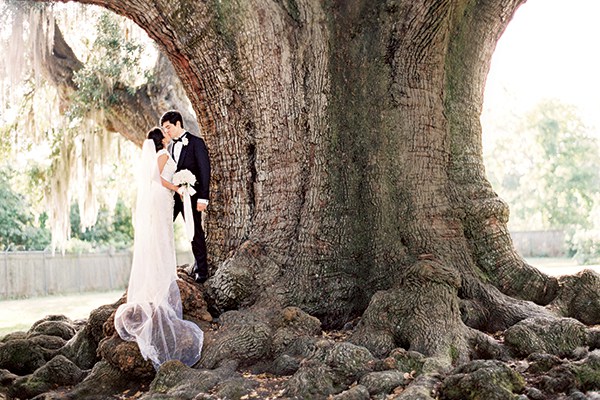
Before the ceremony, the bride and groom pose for pictures underneath a massive oak tree in New Orleans’ Audubon Park.
Five months later, when their schools reopened, Gabriela and David returned to New Orleans. There they found a drastically changed landscape—both visually and socially. “It was a crazy time, especially as a teenager,” remembers Gabriela. “You were depressed because a lot of your friends weren’t coming back at all. I had to make new friends.”
With a smaller social circle, it didn’t take long for the two to meet. What began as a close friendship turned into a romance that would withstand five years of long distance as David attended the University of Louisiana in Lafayette and Gabriela went to Louisiana State University in Baton Rouge.
After graduation, both decided they wanted to return to New Orleans and be a part of rebuilding the city. They bought a house together, fixed it up, and rented it out—their small but meaningful contribution to the city’s revitalization. David proposed a year later after dinner at Brennan’s and a walk by the river.
Initially, Gabriela wasn’t sure what kind of wedding she wanted. “I didn’t know if we wanted a big wedding or a small wedding, a wedding in New Orleans or a destination wedding,” she says. Much of the couple’s families live out of the country, so travel would be involved for many guests. Ultimately the allure of their beloved city sealed the deal. “New Orleans is such a fun place to get married,” says Gabriela. “We have so many quirky traditions.”
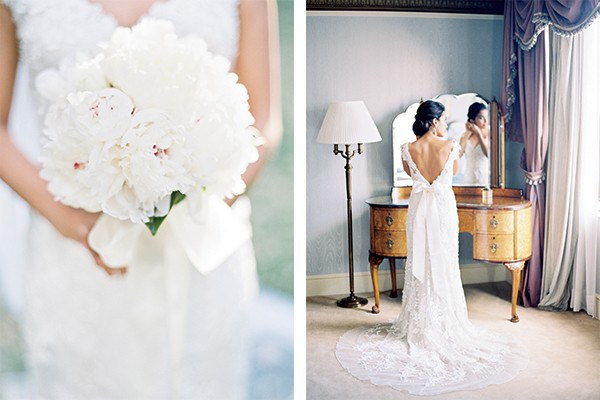
The bride’s full bouquet of frothy white peonies complemented her elegant lace gown and sash tied in a traditional bow.
With the help of her mother, future mother-in-law, and twin sister, Gabriela set about planning a wedding that would celebrate the couple’s New Orleans home and their Hispanic heritages (her parents are from Honduras; David’s father is from Cuba, and his mother, from Colombia).
A guiding theme for the bride was the idea of timelessness. “I kept asking myself, ‘What will look good 100 years from now?’ We didn’t want anything to look too trendy,” she says. Wedding invitations tucked inside a delicate, gold overlay set a formal tone for the event, inviting guests to a wedding at St. Mary’s Assumption Catholic Church and a reception afterwards at the historic Board of Trade building.

The couple celebrated a wedding Mass at the majestic baroque altar of St. Mary’s Assumption Church.
At seven o’clock in the evening, wedding guests—some who’d crossed city wards to be there, some who’d crossed oceans—gathered in St. Mary’s soaring baroque sanctuary to celebrate Mass. Flower girls in heirloom lace dresses and dainty beaded crowns looked like they’d been plucked from a Velázquez painting as they carried antique copper watering cans full of flowers down the aisle.
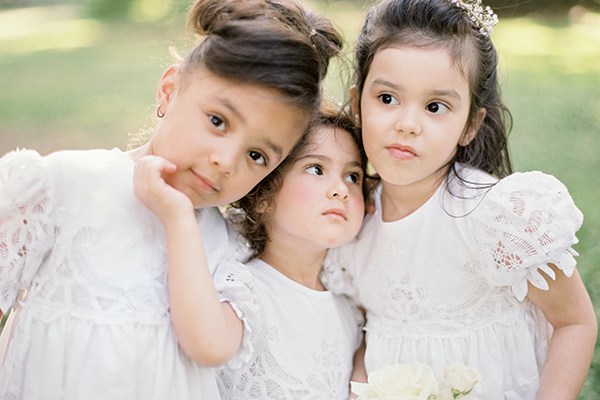
The flower girls wore dresses handmade with lace from vintage tablecloths.
The reception at the Board of Trade felt perfect for the bride. “I wanted the reception in a historical venue that had a lot of character,” she says. Built in 1880, the Board of Trade exudes a stately New Orleans charm with its massive wooden doors, ceiling murals, and chalkboard walls, remnants from the days when traders used to scribble the changing price of coffee.
Floral designer Ashley Bateman, owner of Nola Flora, worked with Gabriela to design flowers that reflected the city’s vibe. “It’s a very Southern feel,” says Bateman of her arrangements of white flowers with camellia and magnolia foliage. “I call the style ‘New Orleans Courtyard.’ It’s more formal than a garden look, which is loose and organic. This was a little more structured and dressy, but the materials are still things that could’ve come from your courtyard.” Because, adds Bateman offhandedly, “Almost everybody has some camellias in their courtyard, you know?”

The bride scoured Gulf Coast thrift stores for antique copper watering cans, which were filled with white roses and hydrangeas for the flower girls.
If Gabriela wanted the wedding to look Southern, she wanted it to sound Spanish. After enjoying a buffet of local cuisine and cocktails such as the French 75 (a local favorite) and Cuba Libre (a nod to the Cuban Delgado clan), a Spanish band opened up with salsa music. Suddenly the dance floor was packed, led by guests from Honduras and Colombia. “All of our relatives know how to salsa,” says Gabriela.
Around Latin America the last hour of a wedding has a special name: La Hora Loca. “You just kind of go crazy,” laughs Gabriela of the tradition she instituted at her reception. The Spanish band made way for a DJ who pumped in pop music and invited guests to look under the tables to find wild hats and props. “My family knew exactly what was going on,” says Gabriela.
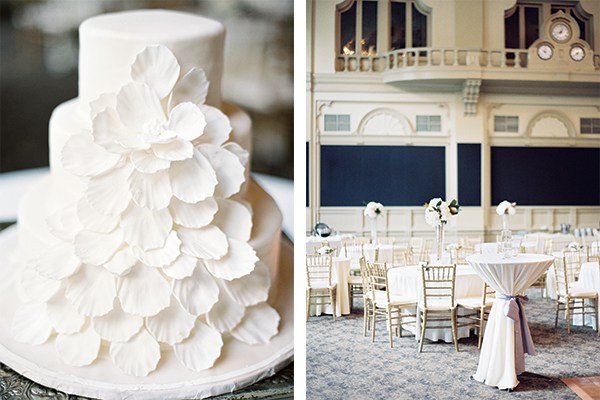
LEFT: “I love the simplicity and elegance,” says the bride of her cake made by Swiss Confectionery, a New Orleans institution. RIGHT: Looking for a historical venue with a lot of character, the bride selected the New Orleans Board of Trade for the reception.
As if that wasn’t enough, at the end of the night the party spilled into the street as a brass band led the bride, groom, and 300 napkin-waving guests in a traditional Second Line parade. It was a quintessential New Orleans scene: two first-generation Americans starting a new life together in a city that is enjoying a new start of its own.
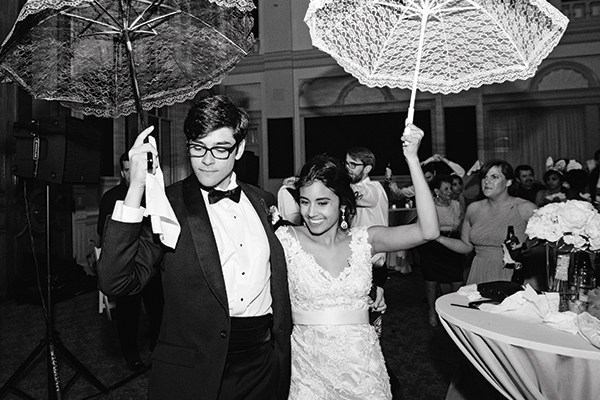
At the end of the reception, the bride and groom led their guests in a traditional Second Line parade through the French Quarter.
FLORAL DESIGN: Ashley Bateman of Nola Flora | PHOTOGRAPHY: Marissa Lambert Photography | CHURCH: St. Mary’s Assumption Church | RECEPTION VENUE: New Orleans Board of Trade | CAKE: Swiss Confectionery | BRIDAL GOWN: Yvonne LaFleur
By Kirk Reed Forrester | Photos by Marissa Lambert



